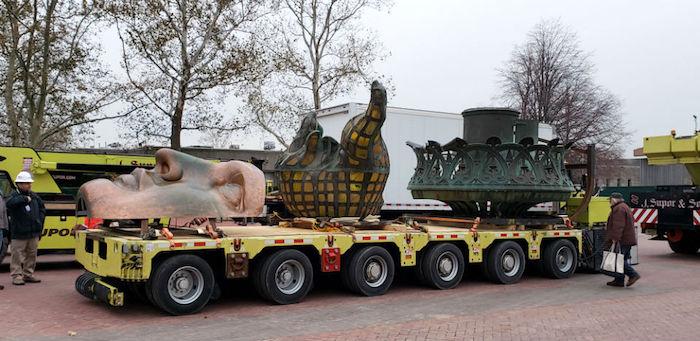
The original torch from the Statue of Liberty has been moved to where a new museum for the national monument will open in spring/NPS
There are two torches that Lady Liberty held high over the Hudson River, and one of them you'll soon be able to walk up to without entering the statue.
The original torch that Frédéric-Auguste Barthold designed and which was held high by Lady Liberty for nearly 100 years was taken down in 1984 as part of the statue’s centennial restoration project. Constructed of gold and copper, the huge torch was placed on display inside the Statue of Liberty Monument’s pedestal. In November 1985, a replica of Bartholdi's original design was installed onto the Statue and formally dedicated during the July 4, 1986, Liberty Weekend centennial celebration.
This past week a team led by the Statue of Liberty-Ellis Island Foundation and the U.S. Department of the Interior/National Park Service disassembled the original torch and moved it from the monument’s pedestal across Liberty Island to the new museum site. A special hydraulically stabilized transporter vehicle took the torch 470 feet across the island before the torch was lifted by crane into the new museum.
“The original torch is a beautiful object of art and exemplifies the American ideals of freedom and democracy - a true national treasure cared for by the National Park Service,” said John Piltzecker, superintendent of the Statue of Liberty National Monument and Ellis Island. “That’s why I’m so pleased that The Statue of Liberty - Ellis Island Foundation’s fundraising campaign has allowed us to relocate it to a more fitting place where all of our visitors, from across the nation and from around the world, will always be able to see it and be inspired by it.”
The 3,600-pound original torch will be the centerpiece of the new Statue of Liberty Museum, a 26,000-square-foot museum that will celebrate the Statue of Liberty’s history, influence, and legacy in the world. Visitors will get an up-close view of the iconic symbol in its new home in the Inspiration Gallery, which features floor-to-ceiling glass panels overlooking the Statue of Liberty and Manhattan skyline. The museum will be free to visitors with the purchase of a ferry ticket to visit Liberty and Ellis Islands and is expected to open to the public in May 2019.
“For nearly a century, the Statue of Liberty’s original torch was viewed by millions of immigrants as they came to America in search of better lives. Unfortunately, today only one-fifth of the visitors who come to Liberty Island can enter the monument and see the original torch in person,” said Stephen Briganti, president and CEO of The Statue of Liberty-Ellis Island Foundation. “We’re thrilled to be able to give all guests to Liberty Island the opportunity to see this unparalleled piece of American and world history firsthand, whether from within or outside of the museum.”



Add comment